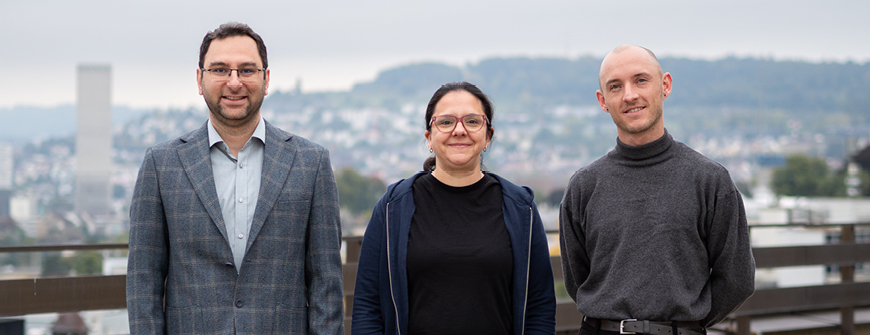Empa Entrepreneur Fellowships awarded
Three researchers receive start-up funding
Ultrathin terahertz optical components, large-area strain sensors and surface microstructuring with high throughput rates: For these innovations, three Empa researchers – Elena Mavrona, Mohammad Jafarpour and Nicolas Zaugg – have been granted this year's Empa Entrepreneur Fellowships, which will enable them to exploit their research to develop innovative products.

The one-year Empa Entrepreneur Fellowship is a kind of scholarship. It is awarded to candidates who want to become entrepreneurs based on their research at Empa. The fellowships are awarded in a competitive process to ensure that the applications with the highest market potential and the candidates with the most promising entrepreneurial qualities are selected. This year, they were awarded for the fourth time to young researchers.
The jury, consisting of internal and external experts, awarded three such fellowships this year. The grant allows the fellows to further develop the application-oriented research for an innovative product or a sophisticated service in these twelve months and to prepare its commercialization.
Ultrathin optical components for manipulating terahertz radiation
Terahertz radiation is the part of the electromagnetic spectrum between the short wavelength visible and infrared light and longer microwaves at gigahertz frequencies. Long considered a promising technology for the introduction of the 6G standard for wireless communication, it also enables numerous other applications, ranging from medical diagnostics to space research and security checks. However, the current optical terahertz components suffer from poor performance and availability.
With a patented manufacturing platform, Elena Mavrona and her spin-off Lepto GmbH develop ultra-thin, highly efficient terahertz optical components and devices with superior frequency selectivity and seamless system integration. Successful pilot sales to research groups in Switzerland and Germany confirm the great market interest and the added value for customers.
Elena Mavrona plans to use the grant to further develop the innovative core product, the terahertz bandpass filter, and to complete the polarizers, optimize the low-pass filters and improve the product design. Lepto GmbH will become more visible on the market, among other things, through targeted PR, publications, participation in conferences and the search for strategic partnerships with original equipment manufacturers in the fields of spectroscopy and imaging. “In addition, we will acquire important materials and necessary equipment to support research and development as well as prototype production,” says the new fellow.
High-resolution printed strain sensors for infrastructure monitoring
Structural Health Monitoring (SHM) is crucial for ensuring the safety, reliability and performance of modern infrastructures. While digital systems have made rapid progress, sensor hardware remains limited in terms of cost and scalability – particularly with respect to resolution and sensitivity. The project of Empa Fellow Mohammad Jafarpour aims to close this gap with a sensor platform based on high-resolution gravure printing, combining industrial scalability with a precision of below 10 μm.
The project employs a patented laser-based engraving process to enable sub-10 μm structuring through roll-to-roll compatible gravure. This approach enables the production of lightweight, flexible strain sensors with enhanced resolution and sensitivity. The initial focus lies on wind turbine blades, where distributed strain monitoring can support aerodynamic optimization and reduce maintenance efforts.
In addition to the technical objectives, the project also includes a commercialization roadmap. "Over a period of twelve months, I aim to develop and test sensor prototypes, assess manufacturability, and explore the foundation of a start-up,” says Jafarpour.
Large-area microstructuring using laser processes
Microstructured surfaces have a wide range of applications in fields such as optics, electronics, biotechnology, energy, transportation and more. By carefully controlling surface topology, it is possible to impart substrates with novel functionalities which are not present in the bulk material. This effect can be exploited for innovative and efficient micro-devices as well as macro-scale products.
The customized 248-nanometer laser ablation tool at the Laser Center at Empa in Thun allows the microstructuring of surfaces in the micrometer to millimeter range with high throughputs and for areas up to several square meters. By drastically lowering the cost compared to classical, wafer-scale cleanroom microfabrication, these unique capabilities offer the potential for groundbreaking applications and products in high-growth sectors such as energy and healthcare.
The group led by award winner Nicolas Zaugg demonstrated the technical capabilities of the system through research projects and initial sales to commercial partners last year. According to Zaugg, the Laser Center "presents a promising high-tech spin-off opportunity to further Empa's mission of translating scientific excellence into industrial applications."
Awardees who have already founded a start-up:
- Federica Bellizio: Kuafu AG, intelligente Energiemanagementplattform
- Elena Mavrona: Lepto GmbH, efficient and scalable terahertz components
- Andyn Omanovic: Etavalve GmbH, thermal power engine for energy generation from industrial waste heat
- David Häusermann: FireDrone AG, drone for firefighting operations and industrial inspections
- Abdessalem Aribia: BTRY AG, thin film batteries
Dr. Elena Mavrona
Lepto GmbH
Phone +41 76 758 46 47
Dr. Mohammad Jafarpour
Empa, Functional Polymers
Phone +41 58 765 61 64
Nicolas Zaugg
Empa, Advanced Materials Processing
Phone +41 58 765 62 18
-
Share






